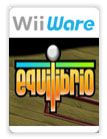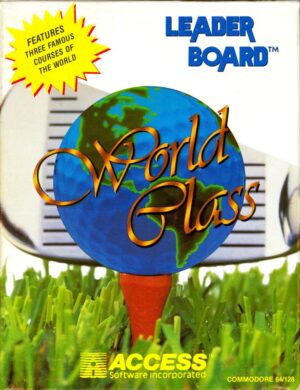Retro Replay Review
Gameplay
Equilibrio delivers a unique blend of action and puzzle-solving by challenging players to manipulate the playfield itself rather than directly controlling the ball. Using the Wii Remote’s motion controls—or by leaning on the Wii Balance Board—the entire level tilts in real time, causing the fragile ball to roll toward the exit. This core mechanic feels intuitive almost immediately, yet each new obstacle or ball type introduces fresh layers of strategy that keep players engaged.
The game features 64 handcrafted levels (60 on the iPhone), each designed to test your precision, timing, and problem-solving. Deadly hazards such as spikes and acid pools demand cautious planning, while sheer drops punish careless tilts. As you progress, you unlock five distinct ball types—rubber, paper, steel, and more—each with unique properties. Some balls compress under pressure but bounce high, while others shatter if dropped from too far, forcing you to adapt your approach constantly.
Equilibrio’s dynamic difficulty system ensures that both newcomers and puzzle veterans remain challenged. The game tracks your performance and subtly ramps up obstacle complexity or tightens time windows when you breeze through early stages. If you’re stuck, optional level skips prevent frustration without penalizing your overall progression. Additionally, five game modes—including a linear unlock path and a grueling Challenge mode—offer diverse ways to tackle the same 64 arenas.
For multiplayer fans, the Wii version adds two versus modes supporting up to four players simultaneously. Racing your friends to the exit or competing to complete mini-challenges feels oddly competitive for what is essentially a physics-based puzzle. The social element extends replayability and showcases how subtle control nuances can create wildly different tactics in a group setting.
Graphics
Visually, Equilibrio adopts a clean, minimalist aesthetic that prioritizes readability over decorative flair. Levels are rendered in crisp, bright colors against simple backdrops, ensuring every obstacle and platform stands out clearly. This design choice not only complements the motion controls but also reduces visual clutter, helping players focus on the delicate task of balancing the ball.
Each ball type boasts its own texture and shading, making it easy to identify in the heat of a fast tilt. Rubber balls gleam with a soft sheen, while steel balls display realistic metallic highlights. Subtle particle effects—like dust when wheels scrape against surfaces or sparks when metallic balls hit spikes—add a satisfying visceral touch without overwhelming the eyes or hindering performance.
The game consistently runs at a smooth frame rate on the Wii, even when multiple physics interactions occur simultaneously. Levels load quickly, and transitions between menus and gameplay remain snappy. On the iPhone version, the graphics are slightly scaled down but retain their clarity and responsiveness, making it a solid on-the-go alternative for puzzle enthusiasts.
Background music and ambient sound effects further enhance the visual presentation by providing subtle audio cues. A gentle chime signals level completion, while a rising tension score warns you of impending time constraints. Although not a visual element per se, this audio-visual harmony makes each stage feel polished and cohesive.
Story
Unlike narrative-driven titles, Equilibrio’s story is conveyed almost entirely through its level progression and challenge structure. There is no traditional plot or characters; instead, the game invites players to explore an abstract, physics-based world of shifting platforms and hazards. This minimalist approach keeps the focus squarely on the puzzles themselves.
Each set of levels subtly introduces new mechanics as if teaching you through gameplay rather than cutscenes or text. For instance, the first appearance of the paper ball comes in a windy chamber that emphasizes lightness and air currents, establishing context without a single word. Later, acidic pools and spike fields arrive like natural evolutions of the core concept rather than forced story additions.
The absence of a concrete story may be a drawback for players seeking emotional engagement or character arcs, but it also frees Equilibrio from narrative constraints. The result is a pure puzzle platformer experience that feels timeless—levels don’t rely on lore or dialogue, so you can jump in at any time and grasp the objectives instantly.
In multiplayer modes, the “story” shifts to competitive camaraderie. Racing friends to the finish line or plotting tricky tilts together creates emergent moments that feel like personal anecdotes. In this way, Equilibrio’s narrative is whatever you and your group make of it at the moment.
Overall Experience
Equilibrio stands out in the crowded puzzle genre thanks to its inventive tilt-to-move mechanic and its careful balance of accessibility and depth. Whether you’re tackling the early, forgiving stages or grinding through the later Challenge levels, the game continually rewards precision, experimentation, and strategic planning.
The inclusion of five specialized balls transforms each level from a simple tilt exercise into a layered puzzle. Switching from a steel ball that plows through obstacles to a delicate paper ball that sneaks across fans keeps the gameplay loop fresh across dozens of hours. Optional skips and dynamic difficulty help bridge skill gaps, making Equilibrio friendly to both casual players and hardcore puzzle fans.
Graphically and technically, the title performs admirably on the Wii, and the iPhone port retains the core experience with only minor compromises. Multiplayer modes, though limited to the Wii, inject a competitive spark that’s surprisingly addictive, prompting multiple replays of favorite levels just to outdo friends.
For anyone seeking a physics-driven puzzle adventure with tight controls, thoughtful level design, and a wealth of content, Equilibrio offers exceptional value. Its lack of traditional story might disappoint some, but the emergent narratives born from your own near-misses and triumphant finishes more than make up for it. Tilt, lean, and conquer—Equilibrio delivers a satisfyingly balanced ride.
 Retro Replay Retro Replay gaming reviews, news, emulation, geek stuff and more!
Retro Replay Retro Replay gaming reviews, news, emulation, geek stuff and more!









Reviews
There are no reviews yet.